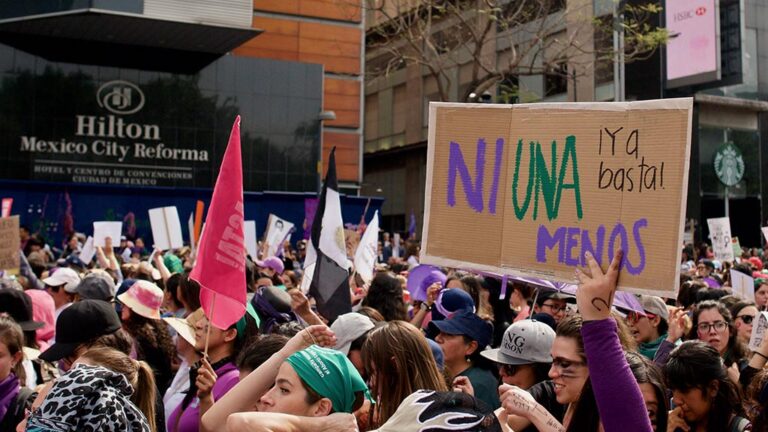On International Women’s day, Mexican women gathered to march the central streets of Mexico City. This is their response to the widespread daily gender-based violence. FUF’s correspondent reports from the march.
It is March 8th and the day of the International Women’s day. The central streets of Mexico City shifts in purple and green, not only because of the jacarandas (Latin American trees), which bloom in violet and leave a shimmer in green during this time of the year. But also because of the tens of thousands of women dressed in purple t-shirts and green scarfs who have taken to the streets this particular Sunday afternoon.
There have never been so many women on the streets around the Monument of Revolution. This is the starting point of “Marcha 8”, which will march the two and a half kilometers to Mexico City’s historical square, el Zocalo. Women from all over Mexico City are singing chants and carrying homemade placards in hope to make their voices heard. The matter is the nation-wide escalating violence against women. It is only the beginning of the month of March but the temperature exceeds 25 degrees Celsius and it quickly gets hot in the crowds. Some participants have brought purple umbrellas, others use their placards as protection against the sun.
Over the last year, Mexican women have started to organize and react more intensively towards the daily situation of the female half of the population. According to official numbers, ten women become victims of femicides each day – meaning that they get killed because of their gender. Last August, women gathered in various cities across the country participating in the “Glitter Revolution” rally, which in the media got highly criticized for vandalism of historical monuments. Internationally, the purple color has come to symbolize the women’s movement, while green symbolizes the demand for abortion rights.
The first sections of demonstrators are intended for families that have been victimes of femicides, mothers with kids below 12 years old, and other supporting women. Thereafter, men are welcomed to participate either on their own or as a part of an organization. There is a significant number of young women demonstrating, whereby some are students and alumni from the university. They go tightly together singing “Ni una más, ni una más, ni una asesinada más!” (Inte ett till, inte ett till, inte ett mord till!”).
– The first reason why I participate in the march is because I don’t feel safe. Being a woman here in Mexico is hard: you always have to be careful of where you are and where you walk, says Alejandra, 25, alumni from la Universidad Iberoamericana.
Along the route of the march, the government has prepared the city with temporary walls around historical monuments to hinder vandalism. But this does not stop a number of black camouflaged women to show their frustration by crashing store windows and painting facades and statues. Some incidents induce concern in the crowd and other participants react by shouting in chorus “No violencia, no violencia”(“No violence, no violence) repetitively until the situations have calmed down. Other protestors have taken the opportunity to color the water of the fountains pink and to attach informative notes on lamp-posts.
In front of one of the many rows of police men, a woman is standing firmly holding a placard towards all passersby. The black text says: ”Dónde estuvieron cuando las mataron?”, (”Where were you (the policemen) when they (the men) killed them (the women)?”). Several protestors stop to catch the moment on picture. A couple of hundred meters further down the street, right in front of the Opera house participants gather in front of a pink statue of a big Venus symbol with a fist in the middle. The chants stop, the crowd gets quiet and everyone puts their fists in the air. For one minute, the collective frustration and anger has turned into a collective sensation of vulnerability and empowerment. The noise of helicopter blades approaches in the sky. The silence is now replaced by screams, and the fists by open, waving, palms.
The next day, Monday, March 9th, the streets and squares of the capital echo empty. The first national women’s strike takes place as a part of the movement #UnDíaSinNosotros. Women do not go to work, are not in the streets, do not go to school, and do not engage in any economic activities. They are staying home, demonstrating their great value as economic contributors and citizens, which means a major loss for the Mexican economy according to national newspapers. Only the jacarandas color the silent city’s avenues for 24 hours, but is the government taking notice?


